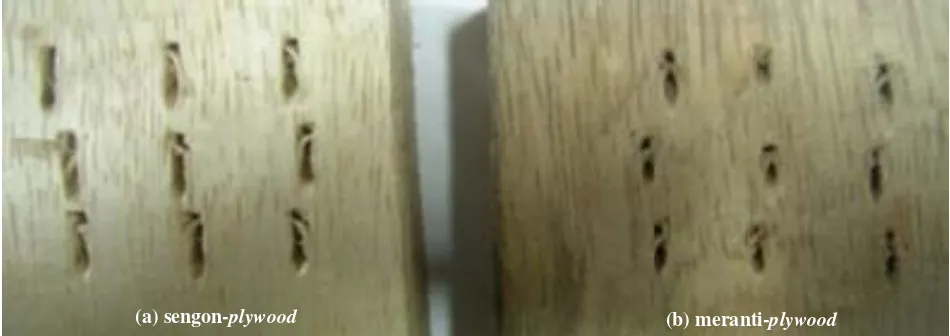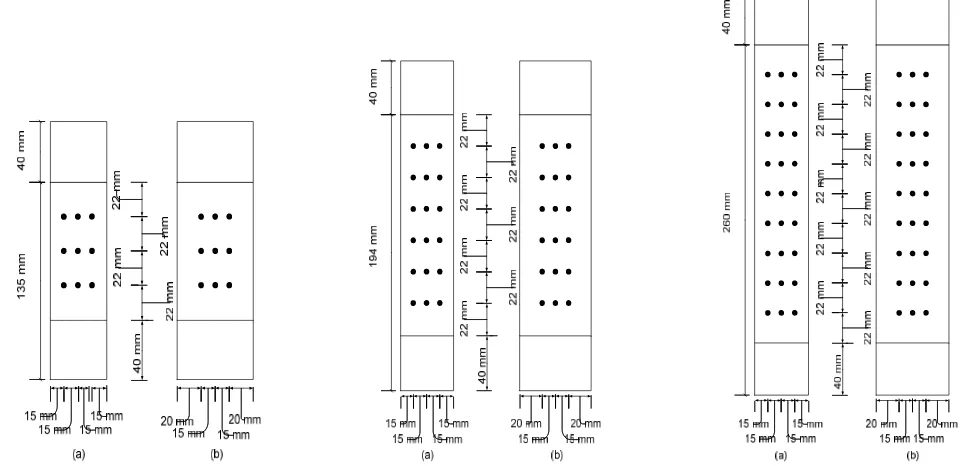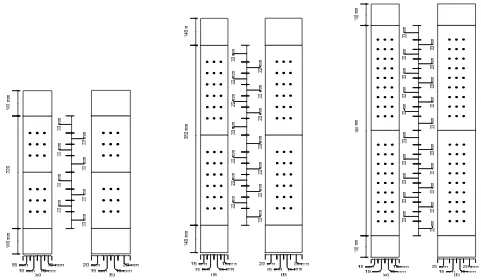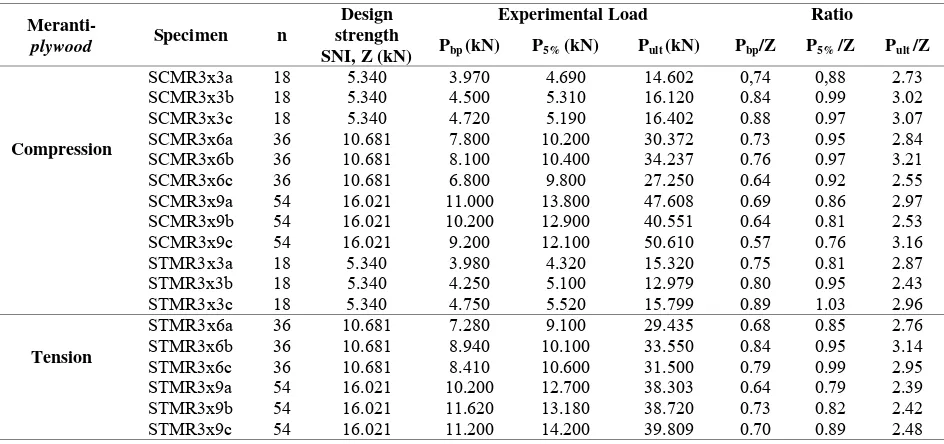1
Vol. 18 No. 1 April 2011 AbstractThe group action factor was observed in this experimental study. The 18 mm thickness of plywood was used as side’s plate and the main members were made from meranti (shorea sp.) and sengon (paraserianthes falcataria) species. The correlations of group action factor with a number of nails in a row was investigated under uni-axial compression loading test with one to ten nails variation in a row. The member connections with multiple 3 rows with 3, 6, and 9 nails in each row were also tested both under uni-axial compression and tension loading. The group action factor correlated to the number of nails for single row was obtained using the regression analysis. The regression equations presented was group action factorat the proportional limit (Cgp), group action factor at the 5% offset diameter (Cg5%), and group action factor at the ultimate load (Cgu). The connection strength at 5% offset diameter and proportional limit was closed to the strength design based on the draft of
Indonesian Timber Code 2000. The ultimate strength is extremely higher than the design value, giving a sufficient safety factor. Based on this result, a simplified group action factor equation for connection with
plywood side’s plate was proposed.
Keywords: Group action factor, proportional limit, 5% offset diameter, ultimate load.
Abstrak
Faktor aksi kelompok diteliti dalam studi eksperimental ini. Plywood dengan tebal 18 mm digunakan sebagai pelat penyambung sisi dan kayu utama terbuat dari meranti (shorea sp.) dan sengon (paraserianthesfalcataria). Korelasi antara faktor aksi kelompok dengan jumlah paku dalam satu baris diteliti dari pengujian dengan beban tekan uni-aksial dengan variasi satu sampai dengan sepuluh buah paku. Sambungan dengan 3 baris majemuk dengan 3, 6, dan 9 paku dalam satu baris juga diuji dengan uji beban tekan dan tarik uni-aksial. Faktor aksi ke-lompok yang dikorelasikan dengan jumlah paku untuk satu baris didapat dari analisa regresi. Persamaan-persamaan regresi yang disajikan adalah faktor aksi kelompok pada batas proporsional (Cgp), faktor aksi
kelompok pada 5% offset diameter (Cg5%) dan faktor aksi kelompok pada batas ultimit (Cgu). Kekuatan sambungan pada 5% offset diameter mendekati kekuatan sambungan dari harga disain berdasarkan
draft Peraturan Kayu Indonesia 2000. Kekuatan ultimit sambungan jauh lebih tinggi dari harga disain, memberikan faktor keamanan yang memadai. Berdasarkan hasil kajian ini, suatu persamaan sederhana untuk perhitungan faktor aksi kelompok dengan pelat penyambung sisi plywood disarankan.
Kata-kata Kunci: Faktor aksi kelompok, batas proporsional, 5% offset diameter, beban ultimit.
Group Action Factor of Nail Fastener on the Wood Connection
With Plywood Sides Plate
Johannes Adhijoso Tjondro
Civil Engineering Department Parahyangan Catholic University, Bandung, Indonesia Email: [email protected], [email protected]
Evan Kurnia Rosiman
Alumni of Civil Engineering Department Parahyangan Catholic University, Bandung, Indonesia
Jurnal Teoretis dan Terapan Bidang Rekayasa Sipil Jurnal Teoretis dan Terapan Bidang Rekayasa Sipil
1. Introduction
The connection failure modes may depend on the properties of wood main member, wood side plate and nail. Several failure modes may occur as shown in Figure 1. There are six failure modes possible for single shear and four failure modes for double shear connections, Soltis 1999. The connection design strength due to axial load of single nail was different from the strength of a group of nails because the force
was not distributed uniformly in each nail.
The basic nail strength for different yield modes in the draft of Indonesian Timber Code (SNI-03-xxxx-2000) which is adopted from NDS (AWC, 2005) may be calculated by Equations (1) to (6). The experimental result of the multiple nail connections was compared to this design value to evaluate the group action factor. In the NDS 2005, besides number of nail; type of fastener, ratio of the axial stiffness of wood and side’s plate, slip modulus between the main member and side’s plates and spacing of the fastener were needed to determine the value of Cg. In this experimental study,
the complicated equation of Cg in NDS 2005 for wood
connection with plywood sides plate is going to be sim-plified based on number of nails. The single nail strength at possible failure modes are:
where:
Figure 1. Yield modes on the connections (a) single shear (b) double shear
Source: Soltis (1999)
The design of single nail strength N calculated by Equations (1) to (6). The wood and plywood proper-ties to calculate single nail strength was based on the material properties test results as was shown in Table 1. And the design of adjusted single nail strength Z’ calculated by Equation (7).
Where: the design of connection strength Z calculated by Equation (8).
where
Z = design of connection strength (N) n = total number of nail
z = resistance factor = 0.65
2. Method and Materials
This research based on the theoretical and experi-mental studies. The materials were tested based on the ASTM D143-94 standard testing for small clear speci-men, ASTM 2005. The main member of the specimen was designed using sengon species which has lower specific gravity (G) than plywood, and meranti species which have higher specific gravity as shown in Table 1. The single row specimen was tested under uni-axial compression loading and the multiple rows connection was tested both under uni-axial compression and
3
Vol. 18 No. 1 April 2011 Based on the material properties in Table 1 andEqua-tions (1) to (6), the design strength of a single nail was calculated. The result was then presented in Table 2. It was shown that the critical failure mode for sengon with lower specific gravity than plywood was mode IlIm
and for meranti with higher specific gravity than ply-wood was mode IV. The design strength of the connec-tions with multiple nails was as shown in Table 3.
Material G Fc//
Nail diameter= 2mm
G = specific gravity, Fc// = compression strength parallel to the grain, Ft// = tension strength parallel to the grain, mc = moisture content
Source: Rosiman (2007)
Type Yield Mode
Table 2. Adjusted single nail design strength
*) including Cd , **) critical value, predicted failure mode Source: Rosiman (2007)
Type n Connection
strength Z *) (kN) Table 3. The design of connection strengt
*) including z, without Cg Source: Rosiman (2007)
The variation of number of row and nails in one row on the specimens was shown as in Appendices, from Figure A to D and the experimental settings for three rows compression test and three rows tension test were described in Figures 2a and 2b. The test was done under displacement control at 0.6 mm per minute rate using universal testing machine.
Figure 2. Experimental settings (a) three rows compression test, (b) three rows tension test
(a)
(b)
3. Results and Discussion
3.1 The group action factor
The investigation was made to the group action factor at different level of strength, such as at proportional limit (Cgp), 5% offset nail diameter (Cg5%) and ultimate
(Cgu) as described in Figure 3. The compression tests
result for single row was shown as in Table 4 and Figures 4 and 5. The Cg data for regression analysis
was generated from the multiple nail strength divided by n times of single nail strength. Although the data were scattered and have a low R2, the result of Cg at
different level of strength was close.
The result for three rows connection was shown as in Table 5 and Figures 6, 7 and 8. The result of Cg at
compression test at proportional limit was lower than tension test, but the opposite result was occurred for Cg5% and Cgu at three rows test. Although the data of
Figure 4. Group action factor of one row sengon-plywood nail connection
Figure 5. Group action factor of one row meranti-plywood nail connection
Specimen Force Equations*)
R2
Sengon-plywood
Pbp Cgp = 0.906 e-0.02n 0.13 P5% Cg5%= 0.863e-0.01n 0.23 Pult Cgu = 0.912 e-0.01n 0.13
Meranti -plywood
Pbp Cgp = 0.898 e-0.02n 0.18 P5% Cg5%= 0.921e-0.02n 0.14 Pult Cgu = 0.920 e-0.02n 0.19 Table 4. Group action factor for single row
*) without outlier
Specimen Force Equations*) R2
Compression (-)
Pbp Cgp = 0.989 e-0.03n 0.56 P5% Cg5%= 1.020 e-0.02n 0.57 Pult Cgu = 0.959 e-0.01n 0.28
Tension (+)
Pbp Cgp = 1.023 e-0.03n 0.67 P5% Cg5%= 0.995 e-0.02n 0.54 Pult Cgu = 0.938 e-0.02n 0.31 Table 5. Group action factor for three rows
*) without outlier
Figure 3. Typical load vs deflection curve of the connection Pbp
P5%
Pult
5
Vol. 18 No. 1 April 2011 Based on the single and multiple rows tests, thepro-posed conservative simplified group action factor Cg = e -0.03(n-1)
based on Cg =1 for n =1, and Cg = 0.76 for n=10
which is observed manually may be used for design connection with plywood sides plate.
3.2 The strength of connections
The comparison of the experimental strength to the design value was done for both types of specimen as shown in Figures 9 and 10. The result showed that the strength at proportional limit and 5% offset was lower than the design value. It means that without considering Cg the connection will exceed the elastic limit under
design load. But the ultimate strength could achieve 2.5 to 3.0 times the design value as was shown in appen-dices Table A and Table B, giving a significant safety factor to prevent collapse.
Figure 6. Group action factor of three row nail connection at the proportional limit
Figure 7. Group action factor of three row nail connection at the 5% offset nail diameter
Figure 8. Group action factor of three row nail connection at the ultimate strength
3.3 The failure modes
The Failure modes on sengon connection with lower specific gravity than plywood was mode IlIm and for
meranti connection with higher specific gravity than plywood was mode IV, match with the value prediction in Table 2.
Figure 12. Nail failure modes (a) sengon-plywood - mode IIIm, (b) meranti-plywood - mode IV
(a) sengon-plywood (b) meranti-plywood
(a) (b)
Figure 13. Damage on the outside surface of plywood sides plate, (a) sengon-plywood (b) meranti-plywood
(a) sengon-plywood (b) meranti-plywood
Figure 11. Failure at three rows - six nails tension specimen (a) sengon-plywood (b) meranti-plywood At tension test as was shown in Figures 12 to 15,
the nail in sengon-plywood was fail in single curvature and in the meranti-plywood fail in double curvature because the higher specific gravity of meranti.
Plywood has more damage both outside or inside at meranti-plywood connection. The main wood member has more damage for sengon-plywood.
7
Vol. 18 No. 1 April 2011(a) (b)
Figure 14. Damage on the inside surface of plywood sides plate,(a) sengon-plywood (b) meranti-plywood
Figure 15. Damage on the surface of wood main member,(a) sengon-plywood (b) meranti-plywood
(a) sengon-plywood (b) meranti-plywood
4. Conclusions
1. The experimental value of the connection strength at proportional limit and 5% offset diameter was found in between 0.7 – 1.0 of the strength design based on the draft of Indonesian Timber Code (SNI-03-xxxx-2000). It means that the design strength (without Cg) slightly exceeded the elastic range
under the design load.
2. The ultimate strength is more than 2.5 times of the design strength will give a satisfied safety factor from near collapse.
3. It was proof that the failure modes prediction by yield limit equations was accurate and the equations can be applied to calculate the strength of wood connection with plywood side’s plate.
4. The proposed simplified group action factor Cg =
e-0.03(n-1) may be used for the design connection with plywood side plates to maintain the connection remain in the elastic range under the design load.
References
American Wood Council, 2005, National Design Speci-fication for Wood Construction, American Forest and Paper Association.
American Society for Testing and Materials, 2005, ASTM D 143-94: Standard Methods of Testing Small Clear Specimen of Timber. Baltimore, U.S.A.: ASTM Standards Volume 04.10.
Rosiman, E.K., 2007, Experimental Study on the Tension and Compression Strength of Wood Connections with Plywood Side Plates and Nail Fastener. Skripsi, Parahyangan Catholic Univer-sity.
SNI 03-xxxx-2000, 2000, Tata Cara Perencanaan Konstruksi Kayu Indonesia. Badan Standardisasi Nasional, Indonesia.
Figure A. Single row specimen variations for compression loading test Appendices
9
Vol. 18 No. 1 April 2011Figure C. Multiple rows specimen variations for tension loading test
Figure D. Example of compression specimen with three rows and 6 nails each row (left), tension specimen with three rows and 3 nails for each row (right)
Sengon-plywood Specimen n
Design strength
SNI, Z (kN)
Experimental Load Ratio
Pbp (kN)
P5%
(kN) Pult (kN) Pbp /Z P5% /Z Pult /Z
Compression
SCSN3x3a 18 3.867 2.950 3.850 11.901 0.76 1.00 3.08 SCSN3x3b 18 3.867 3.000 3.890 9.795 0.78 1.01 2.53 SCSN3x3c 18 3.867 2.450 3.910 11.075 0.63 1.01 2.86 SCSN3x6a 36 7.733 5.600 7.420 21.082 0.72 0.96 2.73 SCSN3x6b 36 7.733 5.800 8.000 23.073 0.75 1.03 2.98 SCSN3x6c 36 7.733 4.920 7.120 19.762 0.64 0.92 2.56 SCSN3x9a 54 11.600 7.500 9.600 26.678 0.65 0.83 2.30 SCSN3x9b 54 11.600 7.800 10.100 29.690 0.67 0.87 2.56 SCSN3x9c 54 11.600 8.400 11.250 33.241 0.72 0.97 2.87 STSN3x3a 18 3.867 3.210 3.510 9.751 0.83 0.91 2.52 STSN3x3b 18 3.867 3.100 3.870 11.571 0.80 1.00 2.99 STSN3x3c 18 3.867 2.900 3.250 11.041 0.75 0.84 2.86
Tension
STSN3x6a 36 7.733 5.950 7.390 20.969 0.77 0.96 2.71 STSN3x6b 36 7.733 5.200 6.520 19.174 0.67 0.84 2.48 STSN3x6c 36 7.733 6.150 7.010 20.532 0.80 0.91 2.66 STSN3x9a 54 11.600 6.920 8.200 28.562 0.60 0.71 2.46 STSN3x9b 54 11.600 7.810 8.820 32.927 0.67 0.76 2.84 STSN3x9c 54 11.600 7.620 9.550 29.013 0.66 0.82 2.50 Table A. Ratio of experimental to design strength of sengon-plywood connection
Meranti-plywood Specimen n
Design strength SNI, Z (kN)
Experimental Load Ratio
Pbp (kN) P5% (kN) Pult (kN) Pbp/Z P5% /Z Pult /Z
Compression
SCMR3x3a 18 5.340 3.970 4.690 14.602 0,74 0,88 2.73 SCMR3x3b 18 5.340 4.500 5.310 16.120 0.84 0.99 3.02 SCMR3x3c 18 5.340 4.720 5.190 16.402 0.88 0.97 3.07 SCMR3x6a 36 10.681 7.800 10.200 30.372 0.73 0.95 2.84 SCMR3x6b 36 10.681 8.100 10.400 34.237 0.76 0.97 3.21 SCMR3x6c 36 10.681 6.800 9.800 27.250 0.64 0.92 2.55 SCMR3x9a 54 16.021 11.000 13.800 47.608 0.69 0.86 2.97 SCMR3x9b 54 16.021 10.200 12.900 40.551 0.64 0.81 2.53 SCMR3x9c 54 16.021 9.200 12.100 50.610 0.57 0.76 3.16 STMR3x3a 18 5.340 3.980 4.320 15.320 0.75 0.81 2.87 STMR3x3b 18 5.340 4.250 5.100 12.979 0.80 0.95 2.43 STMR3x3c 18 5.340 4.750 5.520 15.799 0.89 1.03 2.96
Tension







